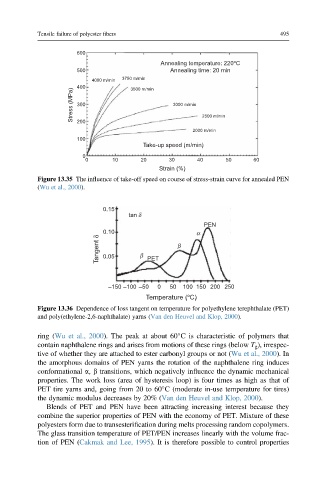Page 522 - Handbook of Properties of Textile and Technical Fibres
P. 522
Tensile failure of polyester fibers 495
600
Annealing temperature: 220ºC
500 Annealing time: 20 min
4000 m/min 3750 m/min
400 3500 m/min
Stress (MPa) 300 3000 m/min 2500 m/min
200
2000 m/min
100
Take-up speed (m/min)
0
0 10 20 30 40 50 60
Strain (%)
Figure 13.35 The influence of take-off speed on course of stress-strain curve for annealed PEN
(Wu et al., 2000).
0.15
tan δ
PEN
0.10 α
Tangent δ 0.05 β PET β
–150 –100 –50 0 50 100 150 200 250
Temperature (ºC)
Figure 13.36 Dependence of loss tangent on temperature for polyethylene terephthalate (PET)
and poly(ethylene-2,6-naphthalate) yarns (Van den Heuvel and Klop, 2000).
ring (Wu et al., 2000). The peak at about 60 C is characteristic of polymers that
contain naphthalene rings and arises from motions of these rings (below T g ), irrespec-
tive of whether they are attached to ester carbonyl groups or not (Wu et al., 2000). In
the amorphous domains of PEN yarns the rotation of the naphthalene ring induces
conformational a, b transitions, which negatively influence the dynamic mechanical
properties. The work loss (area of hysteresis loop) is four times as high as that of
PET tire yarns and, going from 20 to 60 C (moderate in-use temperature for tires)
the dynamic modulus decreases by 20% (Van den Heuvel and Klop, 2000).
Blends of PET and PEN have been attracting increasing interest because they
combine the superior properties of PEN with the economy of PET. Mixture of these
polyesters form due to transesterification during melts processing random copolymers.
The glass transition temperature of PET/PEN increases linearly with the volume frac-
tion of PEN (Cakmak and Lee, 1995). It is therefore possible to control properties

